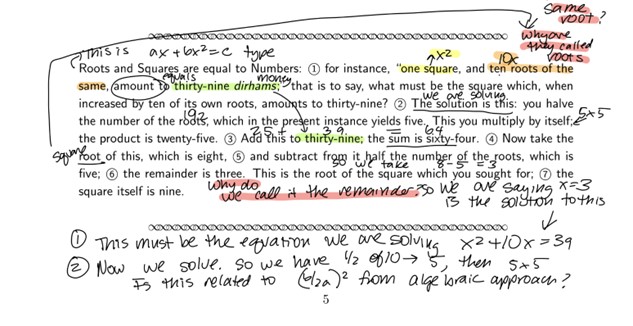- About MAA
- Membership
- MAA Publications
- Periodicals
- Blogs
- MAA Book Series
- MAA Press (an imprint of the AMS)
- MAA Notes
- MAA Reviews
- Mathematical Communication
- Information for Libraries
- Author Resources
- Advertise with MAA
- Meetings
- Competitions
- Programs
- Communities
- MAA Sections
- SIGMAA
- MAA Connect
- Students
- MAA Awards
- Awards Booklets
- Writing Awards
- Teaching Awards
- Service Awards
- Research Awards
- Lecture Awards
- Putnam Competition Individual and Team Winners
- D. E. Shaw Group AMC 8 Awards & Certificates
- Maryam Mirzakhani AMC 10 A Awards & Certificates
- Two Sigma AMC 10 B Awards & Certificates
- Jane Street AMC 12 A Awards & Certificates
- Akamai AMC 12 B Awards & Certificates
- High School Teachers
- News
You are here
Primary Source Projects and Reading Apprenticeship in Mathematics History: Routine #1 — Talk to the Text with al-Khwārizmī
In the mini-PSP Completing the Square: From the Roots of Algebra, by Daniel E. Otero [2019], students explore the rhetorical algebra approach to completing the square used by Muḥammad ibn Mūsā al-Khwārizmī (ca 780–850 CE). They are asked to make connections between modern approaches to solving quadratic equations algebraically (by using the quadratic formula) and al-Khwārizmī’s procedures for solving particular forms of quadratic equations, which he referred to as “compound species.” Figure 6 below shows a page from al-Khwārizmī’s algebra text, Kitāb al-jabr wa’l-muqābala. On this page is the proof of the rule that he gave for solving a quadratic equation of the form “squares and roots are equal to numbers.”

Figure 6. Excerpt from al-Khwārizmī’s Kitāb al-jabr wa’l-muqābala.
Convergence Mathematical Treasures.
In Tasks 3 and 4 in the PSP, students are given an excerpt from the original text and directed to formulate their problem-solving steps using symbolic algebra. We facilitated these tasks using an RA routine called “Talk to the Text.” In this routine, while they read students write comments about their reactions to the text, including predicting, questioning, clarifying, summarizing, and making connections (see downloadable resource for Talking to the Text Inquiry). This routine can also be done verbally as a “Think-Aloud.” The purpose of the routine is to write or say the thinking that we do, but typically do not record or verbalize, while reading. Figure 7 is a sample response for the Talk to the Text from Task 3.

Figure 7. Talk to the Text Sample.
A closer look at the content of Figure 7 illustrates this RA routine. The student first recognized that the phrase “Roots and Squares are equal to Numbers” is equivalent to the modern algebraic equation \(ax + bx^2 = c\). This is further reinforced by the student’s recognition of “one square, and ten roots of the same, amount to thirty-nine dirhams” as equivalent to the equation \[x^2 + 10x = 39,\] as seen in the student’s first note.
The student then traced the solution but not without asking the question, “Why do we call it the remainder?” In the student’s second note they asked if the number 5 (which appears as the result of half of 10) “is . . . related to \(\left(\frac{b}{2a}\right)^2\) from [the] algebraic approach.” Although the student did not pursue the answer to the question, student notes (1) and (2) both indicate a deeper level of thinking than might be accomplished with a purely symbolic approach. By asking the question, the student was demonstrating the ability to make connections, which is one of the aspects that the task was designed to support.
Overall, the student’s work showed evidence of engaging with the text in a way that was meaningful and informative. Following this, the student had no trouble completing Task 4 from the PSP, in which the student translated al-Khwārizmī’s steps into modern algebraic expressions.
Jennifer Clinkenbeard (California State University, Monterey Bay), "Primary Source Projects and Reading Apprenticeship in Mathematics History: Routine #1 — Talk to the Text with al-Khwārizmī," Convergence (November 2023)




